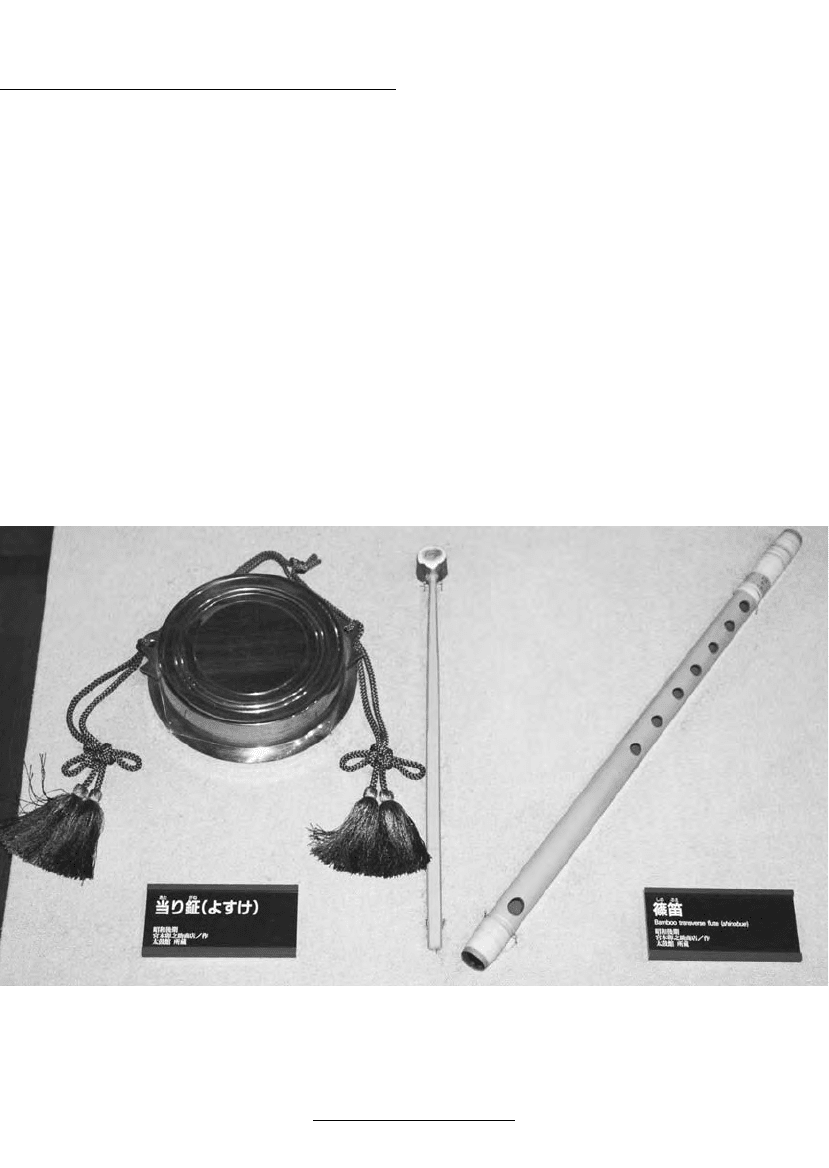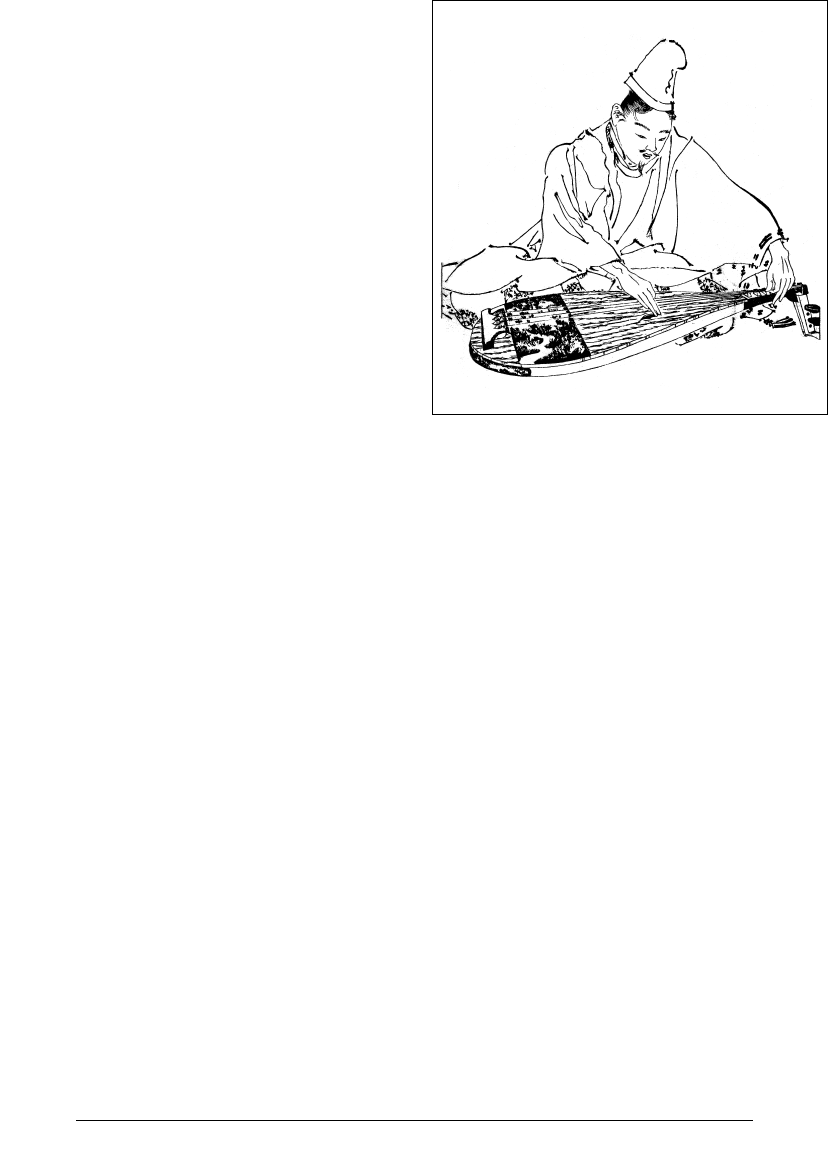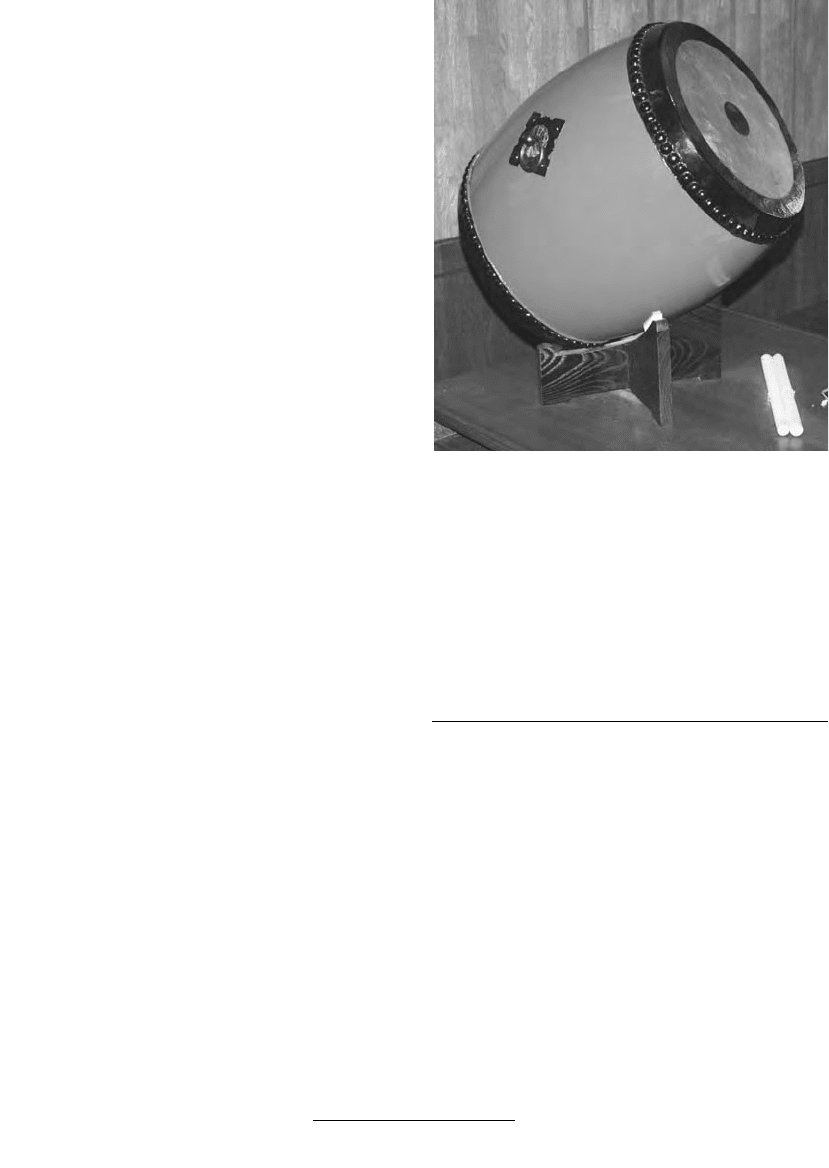Deal W.E. Handbook To Life In Medieval And Early Modern Japan
Подождите немного. Документ загружается.


INTRODUCTION
Medieval and early modern Japanese performing
arts included music, song, dance, theater, folk per-
forming traditions, and storytelling. It is misleading,
though, to assume that these different performance
modes can be treated as if they are fundamentally
separate arts. In fact, these different performing arts
are intertwined in ways that make it difficult to cre-
ate distinct boundaries. Two examples illustrate this
point. First, religious performing arts included both
music and dance that were often performed toge-
ther. Second, Japanese theatrical forms, such as
Kabuki, contain music and dance, as well as acting.
While the following discussion will make certain
distinctions between kinds of performing arts, they
will often be interconnected.
Prior to the medieval period, Japanese perform-
ing arts were strongly influenced by continental
traditions. Early Japanese music—that is, music
prior to the start of the medieval period—was influ-
enced by Chinese and Korean court music and by
Buddhist ritual performance traditions. Dance and
other performance arts were similarly influenced by
Chinese and Korean culture. The history of tradi-
tional Japanese music and dance dates to the Nara
period (710–794). These early performance arts
were based in the court music of Tang-dynasty
China (618–907), known as gagaku, and Buddhist
liturgical music. Gagaku, the earliest extant court
performance tradition of music and dance, was per-
formed during the medieval and early modern peri-
ods, but this imperial court tradition fell out of favor
with the rise of the warrior class at the beginning of
the medieval period.
As in so much of medieval and early modern
Japanese cultural expressions, warrior sensibilities
had a significant influence on the development of
performing arts. In the medieval and early modern
periods, new forms of music developed alongside the
older traditions, which continued throughout these
periods. In the Kamakura period, the ritual perfor-
mance of gagaku was continued on a limited basis;
however, the popular music of the period was
derived from new traditions of song and theatrical
performance. Among these developments were
chanted recitations set to biwa music that recounted
the exploits and heroics of warriors in the Gempei
War in which the Taira and Minamoto battled over
control of Japan.
A later medieval development was the Noh
theater. This dramatic performing art combined
music and dance, and became popular with the
warrior class, enjoying the patronage of Ashikaga
shoguns. Noh drama consisted of highly ritualized
chanted narratives wedded to Buddhist themes and
aesthetics.
In the early modern period, there were two sig-
nificant influences on the performing arts: the dif-
fering aesthetics of warriors and merchants. The
rise of the merchant class in the large cities of
Edo-period Japan became the catalyst for an
urban cultural style that was significantly different
from that of the warrior class. The emerging mer-
chant culture, and the performing arts associated
with it, prospered in the largest cities, Edo, Osaka,
and Kyoto. The licensed pleasure quarters became
the place for merchants to go for theatrical en-
tertainment that more closely reflected their
aesthetics and interests than older forms, such
as Noh. Among the new types of theater were
Kabuki and Bunraku, as well as new forms of
music and song that were performed with koto
accompaniment.
In the Edo period, three instruments that are
closely associated with Japanese music today became
central to different early modern musical traditions.
These three instruments were the shamisen, the 13-
string koto, and the shakuhachi. These instruments
became important components of theatrical music as
well as instruments to be played in concerts separate
from the theater.
Because music was central to most medieval
and early modern performing arts, musical instru-
ments are discussed first, followed by music and
dance traditions, including religious performing
arts. Formal theater traditions—both medieval and
early modern—are then discussed, along with brief
comments on popular street performing arts in
Edo.
H ANDBOOK TO L IFE IN M EDIEVAL AND E ARLY M ODERN J APAN
264

MUSICAL
INSTRUMENTS
Traditional Japanese musical instruments include a
variety of wind and string instruments, as well as dif-
ferent kinds of drums and percussion instruments.
Wind instruments include end-blown and side-
blown flutes and reed instruments. Among the tradi-
tional string instruments used in traditional Japanese
music are a variety of zithers, long and short lutes,
and one bowed string instrument. Drums and other
percussion instruments include both large and hand-
held drums, and a variety of gongs, bells, and wood-
en clappers. Some important examples of Japanese
instruments are discussed below.
WIND INSTRUMENTS
shakuhachi The shakuhachi is a rim-blown bamboo
flute that utilizes five finger-holes to produce its dis-
tinctive sound. The shakuhachi derives its name from
its length as traditionally measured: 1 shaku, eight sun
(the character for sun is also read hachi), approxi-
mately 21.5 inches. It was originally imported from
China in a six–finger-hole version. Although there
are references to the shakuhachi in medieval texts, it
was not until the late medieval and early modern
periods that the instrument became important
through its association with Zen Buddhist monks.
Later in the Edo period, the shakuhachi was played by
warriors and others as a leisure activity. As a result,
new repertoire developed to accommodate these
musical interests. Ensembles known as sankyoku
(“three parts”), consisting of shakuhachi, koto, and
shamisen, also became popular in the Edo period.
hichiriki The hichiriki is a cylindrical double-reed
instrument used in the performance of gagaku court
music. It is made of bamboo wrapped with cherry
bark and lacquered. The instrument has seven fin-
ger-holes in front and two thumb-holes in back, and
it uses a reed in oboelike fashion. The hichiriki is
P ERFORMING A RTS
265
9.1 Examples of Edo-period musical instruments (Edo-Tokyo Museum exhibit; Photo William E. Deal)

descended from a similar instrument played in
Tang-period China (618–907) court music.
sho Along with the hichiriki, the sho, a free-reed
mouth organ, is integral to traditional gagaku court
music. The sho is constructed of 17 bamboo pipes of
different lengths set in circular fashion in a cup-
shaped wind chest. The sho musician can produce
sound by both the inhalation and exhalation of air
through a mouthpiece inserted into the wind chest.
By opening and closing holes in the pipes, a rather
ethereal sound is produced. The full name of this
instrument is hosho, or phoenix sho, a colorful refer-
ence to the idea that the instrument is like a phoenix:
the sho is said to sound like the cry of a phoenix, its
shape has the appearance of a phoenix, and the
arrangement of pipes resemble a phoenix’s wings.
The sho is descended from a Tang-period Chinese
instrument known as a sheng.
STRING INSTRUMENTS
biwa The biwa is a pear-shaped plucked string
instrument that resembles a lute. It is descended
from a Chinese instrument, the piba, and its appear-
ance in Japan dates back at least to the Nara period,
when it was used in the performance of court music.
In the Heian period, it was played by aristocratic
men and women as a leisure activity. The biwa also
had strong associations with Shinto and Buddhist
religious rituals, and Buddhist bodhisattvas and
Shinto kami are sometimes shown playing the biwa.
In the medieval period, the heikyoku tradition of
chanted war narratives—accompanied by the biwa
and song by performers known as “lute priests” (biwa
hoshi)—became popular. Also in the medieval period,
a style of biwa playing, known as Satsuma biwa,
became popular. The name for this style comes from
the Satsuma domain controlled by the Shimazu fam-
ily, who promoted this music as morally edifying. In
the Edo period, the biwa was largely eclipsed in
importance by the newly introduced shamisen.
Competing biwa schools developed that pro-
moted different styles of playing, systems of tuning
and musical notation, and instruments with varia-
tions in the number of strings and frets. Although
four strings was the most common form, some biwa
used three strings while others used five strings.
shamisen The shamisen (or samisen in the dialect of
the Osaka and Kyoto areas) is a three-string plucked
lute. It is descended from a similar instrument
imported to Japan in the middle of the 16th century
from the Ryukyu Islands (Okinawa). Once in Japan,
the shamisen quickly replaced the biwa as the lute of
choice. It also became the central instrument in
early modern Kabuki and Bunraku theater music.
The instrument was associated with the geisha of the
urban pleasure quarters, who played it as part of the
entertainment they provided to their customers.
Later in the early modern period the shamisen and
the songs sung to its accompaniment (called nagauta,
or “long song”) were performed in concert settings,
often in the homes of wealthy merchants and other
patrons. Like the biwa, different playing styles and
instrument configurations were developed for the
shamisen.
koto The koto is a 13-string zither-like instrument
with a paulownia wood soundboard. The instrument
uses moveable bridges for each string to adjust the
tuning, which allows for the variety of tunings used
H ANDBOOK TO L IFE IN M EDIEVAL AND E ARLY M ODERN J APAN
266
9.2 Musician playing a biwa (Illustration Kikuchi Yosai
from Zenken kojitsu, mid-19th century)

in koto music. To play the koto, the musician uses
finger picks on the thumb, index, and middle fingers
of the right hand to pluck the strings, and uses the
left hand to press down on the strings to modulate
the tone or raise the pitch that the plucked string
produces. The koto is descended from the Chinese
instrument known as a zheng.
The koto was first used in Japan in the Nara
period in performances of court music. In the Heian
period, the koto was used to accompany singers of
popular songs, while during the medieval period, it
was used as a solo instrument and as an accompani-
ment to Buddhist ritual chanting. As the koto grew
in popularity as a solo instrument, new musical
styles, sometimes including vocals, developed for the
instrument. In the Edo period, the koto became a
favorite instrument of urban merchants.
kokyu The kokyu is a bowed lute and was the only
bowed musical instrument in use in Japan in the
late medieval and early modern periods. The kokyu
has a long neck and three strings, although after
the late 18th century, some kokyu adopted a fourth
string. The kokyu has its origins in the Ryukyu
Islands (Okinawa). It is a hybrid instrument derived
from both European (the Portuguese rebec) and
Asian antecedents (the shamisen). The kokyu was
first used in Japan in the late 16th or early 17th
century, but it was not until the 18th century that
the instrument became fairly widespread. It devel-
oped into an instrument used, along with the
shamisen and koto, in a form of trio music called
sankyoku.
PERCUSSION INSTRUMENTS
taiko The term taiko refers to several kinds of large
drums that were used in a number of different set-
tings, including imperial court music, Noh and
Kabuki theater, and religious festivals. These large
drums rest on the ground and are beaten with thick
sticks to produce a deep rhythmic sound.
tsuzumi Tsuzumi are handheld lacquered wooden
drums in an hourglass shape. Leather skins are used
for the two drumheads. The use of these drums in
Japan dates from before the Nara period. In the Edo
period, these drums were used in both Noh and
Kabuki theater performances. There are both large
(otsuzumi) and small (kotsuzumi) types of tsuzumi.
MUSIC AND DANCE
The association between music and dance has a long
history in Japan. The earliest extant Japanese text,
the Kojiki (Record of ancient matters), tells a story
about Amaterasu, the Sun Goddess, who resides in
the High Plain of Heaven. Amaterasu, in a fit of
anger at her unruly brother, Susanoo, hides herself
away in a cave, thereby casting the world into dark-
ness. Amaterasu refuses repeated entreaties to
emerge from the cave. Finally, one of the other gods
performs a suggestive dance while stomping rhyth-
mically on an overturned bucket, causing the other
gods to laugh and applaud. The curious Amaterasu
pokes her head out the cave to see what all the fuss is
P ERFORMING A RTS
267
9.3 Example of a drum (taiko) (Edo-Tokyo Museum
exhibit; Photo William E. Deal)

about. She is prevented from reentering the cave and
light is restored to the world. Whether this story is
read as an account of a comical music and dance per-
formance or as a shamanic act of ritual dance and
music, the later performers of the Shinto-related rit-
ual performance of kagura (see below), a form of
sacred song and dance, understood the cave event as
the originating moment of this religious performing
art. Subsequent Japanese performing art often com-
bines music and dance to the extent that it is typically
difficult to consider one without the other.
Characteristics of
Traditional Japanese
Music and Dance
There are many different kinds of traditional Japan-
ese music and dance—some religious and some
secular—that are performed on many different occa-
sions. Within this variety, there are some common
characteristics that are typically found in these
diverse modes of performance.
Traditional Japanese music (hogaku) tends to be
oriented toward the voice and narrative, often with
simple instrumental accompaniment. Historically,
though, there are also instrumental traditions; espe-
cially notable are those that developed in the Edo
period. One important aesthetic in Japanese music is
the significance of space (ma), a concept that refers,
in part, to the “space” or silence between notes.
Thus, this notion of space is not just about musical
timing, but also concerns the idea that music is both
the notes played and the silence in between. This
idea of ma also appears in dance as pauses between
movements. Such silences or pauses also add to the
audience’s anticipation of what will come next.
In both music and dance, aesthetics extends to
the way in which the music or dance is performed. It
was usual for each school of music and dance to pre-
scribe aesthetically pleasing and ritually correct ways
of performance, such as how to hold the body or
intonate the words of a song. While we might view
these as simply stylistic differences between compet-
ing performance schools, they were typically viewed
as essential to the “correct” performance. Aesthetic
considerations were never divorced from or treated
as secondary to performance, and audiences were
aware of these matters and responded accordingly
when watching performers sing and dance.
Japanese music mostly uses a pentatonic scale
that tends to focus on the horizontal aspects of
music, that is, melody and rhythm, while simultane-
ously downplaying the use of vertical aspects of
music, such as harmony or chords. Melodies can be
quite complex. Japanese music is typically in duple
meters (that is, 2/4 or 6/8 time). Rhythmically, how-
ever, there is sometimes no steady beat at all, or
when there is, it exhibits a great deal of flexibility.
Different kinds of Japanese music have different
fixed rhythmic patterns. Finally, while there are
Japanese forms of music notation, these were not
regularly used until the Meiji period. Unlike West-
ern music notation, it was common for each instru-
ment to have its own separate notation system.
Traditional Japanese dance is referred to by two
generic terms: mai, which usually refers to dance
techniques through the end of the medieval period,
and odori, which usually refers to early modern
dance traditions. Japanese dance is often highly styl-
ized with deliberate movements meant to convey the
aesthetic or affective mood of the occasion as much
as any specific meaning. Japanese dance also some-
times includes the use of masks, as for instance in
Noh theater and some religious dances. As in music,
the concept of ma (“space”) is an important compo-
nent of Japanese traditional dance aesthetics. In this
instance, ma refers to the space between dance
movements. Thus, both movement and nonmove-
ment are equal partners in conveying meaning in
Japanese dance.
Japanese dance traditions were found in the per-
forming arts of all social classes in the medieval and
early modern periods. Thus, the wide variety of
dance types includes the formal dances of the aristo-
cratic court, dances employed in Noh and Kabuki
theater traditions, dances performed by geisha, and
folk and religious dances performed on ritual and
festival occasions.
H ANDBOOK TO L IFE IN M EDIEVAL AND E ARLY M ODERN J APAN
268

Music and Dance Traditions
GAGAKU AND BUGAKU
The earliest extant forms of music and dance date
back to at least the Nara period. The music tradi-
tion, known as gagaku, and the dance tradition,
known as bugaku, were the music and dance of the
Japanese aristocratic court. These performing arts
were based on a number of influences, including
court music of Tang-dynasty China (618–907),
ancient Korean performing arts, Buddhist liturgical
music, and indigenous Japanese music and dance
traditions associated with Shinto ritual.
Given its influences, it is not surprising that the
performance of gagaku and bugaku often had a ritual
aspect both in its performance at court and also in its
performance at Shinto shrines and Buddhist tem-
ples. Dances often included the use of masks and
brightly colored costumes.
Although this performing art form continued in
the medieval and early modern periods, it was
eclipsed by other music and dance forms that were
more in keeping with the aesthetics and values of the
warrior class and, in the Edo period, the merchant
class as well.
HEIKYOKU
The Kamakura period marked the beginning of the
significant influence of warrior values and aesthetics
on the performing arts. While different warrior tales
were told, stories of the Heike monogatari became the
most popular. This was especially the case in the
development from the early Kamakura period of a
tradition of chanted narratives accompanied by the
biwa (lute) that told the story of the Gempei War
between the Taira and the Minamoto that marked the
beginning of warrior rule and the medieval period.
The text used for these performances was the Heike
monogatari (Tale of the Heike, ca. 1220). This perfor-
mance tradition was known variously as heikyoku
(Heike recitation), heike katari (Heike narrative), and
heike biwa (Heike lute music). It included influences
from both court music and Buddhist chants.
The performance of heikyoku was done by “lute
priests” known as biwa hoshi. These performers were
often blind. They assumed the appearance of itiner-
ant Buddhist priests even when they were not for-
mally ordained. The popularity of these performers
is clear from the fact that in the 14th century the
shogunate sponsored a guild of lute priest perform-
ers who effectively had a monopoly on the telling of
Heike war stories. The heikyoku performance tradi-
tion continued into the Edo period.
ENKYOKU
Another form of medieval-period song was the
“banquet song,” or enkyoku (also called soga, or “feast
songs”). These banquet or party songs were popular
among warriors and court nobles at times of feasting
and celebration. Songs were accompanied by rhyth-
mic percussion and, for some songs, by shakuhachi
accompaniment. The text of some of these songs
still survives although little is known about the
melodies that accompanied them. It is thought,
however, that the occasions when these songs were
performed were considerably less staid than tradi-
tional court performances, likely the influence of
warrior sensibilities. Banquet songs were no longer
performed by the beginning of the early modern
period, but they were the antecedents to the Edo-
period song form known as “short songs” (kouta).
DENGAKU AND SARUGAKU
In the medieval period, the two most important and
popular music and dance forms were sarugaku and
dengaku. They were important because they were
antecedents to the development of the Noh theater.
The term sarugaku is written with characters mean-
ing “monkey music,” but what the notion of monkey
music might refer to is not known. Sarugaku is also
a term that was sometimes used to refer to Noh
theater, underscoring the historical connections be-
tween these two performing arts. The term dengaku
means “field music,” indicating its origins in rituals
performed to promote an abundant rice harvest.
Historical records indicate the popularity of
these two dances in both cities and provinces, and
P ERFORMING A RTS
269

among such notables as Hojo regents and later the
Ashikaga shoguns. By the Muromachi period, both
sarugaku and dengaku performers were organized
into guilds, called za, and enjoyed the patronage of
important temples and shrines. Troupes traveled ex-
tensively, performing in towns, temples, and shrines
in addition to such cities as Kyoto. Unfortunately,
the exact nature of sarugaku and dengaku perfor-
mances is unclear, though in addition to music and
dance, it probably included acrobatics and plays. It is
also likely that by the late 14th century, sarugaku and
dengaku had developed similar repertories though
they remained separate as schools of performance.
It was sarugaku, however, that developed into
Noh theater as a result of the patronage of the third
Ashikaga shogun, Yoshimitsu (1358–1408). In 1374,
he attended the performance of a sarugaku troupe
that included the actors Kan’ami (1333–84) and his
son Zeami (1363–1443). Yoshimitsu was so taken
with the performances that he offered Kan’ami and
Zeami his financial support to further refine and
develop sarugaku into the performing art that came
to be known as Noh theater.
KOWAKAMAI
Originating in the Muromachi period, kowakamai
was a form of dramatic song and dance that related
stories of warriors and their military exploits. The
narratives were taken from the Heike monogatari and
other warrior tales. These warrior stories were
chanted to music by three actors who enacted the
narrated scene in a mimed dance. Musical accompa-
niment included drums and flute. Though kowaka-
mai was a source for later theatrical works, it was
largely a discarded art by the early Edo period.
JIUTA AND KOUTA
Both jiuta (regional songs) and kouta (short songs)
were popular song forms in the early modern
period that were performed to the accompani-
ment of the shamisen. Jiuta were particularly associ-
ated with the Osaka and Kyoto areas. These
regional ballads sometimes included an accompany-
ing dance. As this song form developed, koto and
shakuhachi accompaniment sometimes replaced the
shamisen. Jiuta was one of the important influences
on the nagauta song form that developed in Kabuki
theater. Kouta (also called Edo kouta), were popular
in the city of Edo. Usually, the shamisen is plucked
with a plectrum, but the short song tradition dis-
carded the plectrum and instead used the finger-
nails. This was done in order to produce songs with
a fast tempo at a high pitch. Kouta were often per-
formed by geisha.
FOLK MUSIC
This is a catchall category that is the invention of
modern scholars who have used the term folk music
(min’yo) to describe the many local and regional song
forms. It is difficult to make any but the most gen-
eral of claims about folk music from the medieval
and early modern periods because only scant records
exist of how they were performed or what the verses
might have contained. The best we can do is assume
that folk music preserved today bears at least some
resemblance to their earlier versions. It is also diffi-
cult to decipher the regional origin of songs that
accompanied those who traversed the travel routes
of medieval and early modern Japan. There is some
evidence, though, that folk music traditions influ-
enced more formal song traditions, such as the
medieval banquet songs, Edo period short songs,
and Kabuki songs.
RELIGIOUS
PERFORMING ARTS
Medieval and early modern Japanese religious ritu-
als utilized both music and dance. Depending on the
particular tradition, music might include chanting to
a rhythmic accompaniment or a dance reenacting
stories of the gods. In the medieval and early mod-
ern periods, Shinto, Buddhism, and Christianity
contributed to the religious performing arts.
H ANDBOOK TO L IFE IN M EDIEVAL AND E ARLY M ODERN J APAN
270

Shinto
Shinto is especially associated with a performing art
known as kagura. Kagura is the music and dance of
the kami (deities) and is traced back to the dance
performed to lure Amaterasu, the Sun Goddess, out
of hiding (see “Music and Dance” above). Kagura
was performed in medieval and early modern Japan
as an aspect of rituals asking the gods for blessings
and long life. There are two major categories of
kagura: court kagura (mikagura) and village kagura
(sato kagura).
Court kagura was performed at the imperial
court and at important Shinto shrines connected
with the imperial family. It was formally related to
gagaku court music (see above). By contrast, village
kagura is a term denoting the many different kinds
of ritual music and dance performances that were
enacted at local and regional shrines. There was
great variety in village kagura and sometimes similar
rituals went by different names in different parts of
Japan. However, among the kinds of village kagura
were performances such as miko kagura, a ritual
dance performed by a Shinto shrine shamaness or
priestess; Ise kagura, a ritual performance that
involved an offering of boiled water to the kami;
Izumo kagura, a dance utilizing sacred objects; and
shishi kagura, a version of the so-called lion dance.
The lion dance (shishi-mai) was a ritual performance
in which the dancer or dancers wore lion masks (in
some parts of Japan, the lion more closely resembled
a deer). The lion dance’s ritual function was to dispel
evil and to bring blessings to the community.
Buddhist
Buddhist ritual practice included a number of differ-
ent performance aspects. Most major ritual obser-
vances included some form of music, whether
melodic or rhythmic. Sutra recitation and other
forms of liturgical chant (shomyo) were chanted dif-
ferently depending on the particular Buddhist
school. Chanting and other Buddhist rituals often
included accompaniment by percussion instruments
and sometimes by melodic instruments. Forms of
traditional court dance (bugaku) were sometimes
also employed, especially at temples associated with
the aristocratic class. Buddhist chanting styles also
influenced later forms of Japanese music.
During the Kamakura and Muromachi periods, a
performance known as ennen (long life) was conducted
at Buddhist temples. Long-life ceremonies were con-
ducted as the closing event at various kinds of religious
events and included song and dance, and dramatic
presentations. Ennen may have been a precursor to the
development of the Noh theater, which was heavily
influenced by Buddhist sensibilities and themes.
Playing music also sometimes had explicit reli-
gious implications. For instance, starting in the late
medieval period, itinerant Zen priests known as
komuso (“priests of emptiness”) played a flute called a
shakuhachi (see above) as an aspect of their ritual
practice. Playing the shakuhachi was seen as a spiri-
tual performance similar to meditation. They held
to the notion that it was possible to attain enlighten-
ment while playing the shakuhachi with single-
minded concentration.
Dance was also an important part of the ritual
practice of some Buddhist schools. Of note were the
nembutsu odori and the Bon odori. The nembutsu odori,
or “dancing nembutsu,” was related to faith in the sav-
ing power of Amida Buddha associated with the Pure
Land schools of Japanese Buddhism (see Chapter 6:
Religion for details on Pure Land Buddhism). The
term nembutsu refers to calling on the name of Amida
for spiritual and material assistance with the hopes of
being born in his paradise, known as the Pure Land,
in the next life. The nembutsu dance provided a way
of expressing one’s faith and devotion to Amida. It
was performed while chanting Amida’s name or
singing Buddhist hymns. This dance influenced the
development of other folk performing traditions.
The Bon odori, or Bon dance, was performed
during the annual Bon festival that occurred in
either July or August, depending on the region. This
was a festival in which the living welcomed the spir-
its of deceased relatives back to the realm of the liv-
ing for a brief time. The Bon dance—derived from
the dancing nembutsu—was one of a complex of ritu-
P ERFORMING A RTS
271

als meant to honor the dead, who were believed to
have the power to affect the fortunes of the living.
The Bon dance originated in the Muromachi period
and was performed throughout Japan during the
early modern period.
Christian
In the transition from the medieval and early mod-
ern periods, during the 100 years of contact with
Western European countries such as Portugal and
Spain, beginning in the 1540s, Japan also had its first
contact with Western music. Western musical
instruments such as viols, rebecs (a 3-string bowed
instrument), lutes, harps, claviers, and even a pipe
organ were introduced to the Japanese by European
missionaries and traders. It is reported that in 1591,
a Portuguese music ensemble played a concert of
Western music for Toyotomi Hideyoshi.
The exposure to Western music was largely
Christian in focus. The pipe organ was used for reli-
gious music. Jesuit missionaries introduced Grego-
rian chant. Catholic mass was conducted in Japan
using Western liturgical music. Christian influence
on Japanese music was short-lived, however. West-
ern music largely disappeared from Japan after
Christianity was banned in the 1630s.
THEATER
In the medieval and early modern periods, there
were four major theatrical forms: Noh, Kyogen,
Kabuki, and Bunraku. Of these, Noh and Kyogen
developed in the 14th century, while Kabuki and
Bunraku date from the last half of the 17th century.
The periods in which these theatrical forms origi-
nated suggest the initial patrons for these perform-
ing arts. Noh and Kyogen, dating from the medieval
period, were first patronized by the warrior class,
and especially the shoguns and regents who con-
trolled the military government. Kabuki and Bun-
raku developed in the early modern period and were
an urban art form. The style and stories of these two
theatrical forms were especially appealing to the
newly rising merchant class who patronized both
Kabuki and Bunraku.
One aspect is worth highlighting about the
nature of medieval and early modern Japanese the-
ater that on first glance may seem self-evident: it was
quintessentially a performing art. The notion that
one might read a play was a relatively foreign idea.
Regardless of the playwright’s creative process, the
end product for the audience was the performed
play, not a read one. Thus, although plays are often
treated as Japanese literature, this would have been a
peculiar thought to most medieval and early modern
Japanese literati.
Noh
The Noh theater originated in the late 14th and
early 15th centuries through the artistic creativity of
the actor and playwright Kan’ami (or Kanze Kiyo-
tsugu, 1333–84) and his son, Zeami (or Kanze
Motokiyo, 1363–1443), an actor, playwright, and
Noh theorist. They were both sarugaku performers
(see above), and it was out of their elaborations on
and refinements of sarugaku that Noh evolved into
its own performing arts tradition, with an emphasis
on mime and stylized dance accompanied by music
and song. Noh theater might not have developed
had it not been for the patronage and financial back-
ing of the third Ashikaga shogun, Yoshimitsu, who
had become an enthusiastic supporter of Kan’ami
and Zeami’s sarugaku troupe. It was this patronage
that afforded Kan’ami—and later, Zeami—the
resources needed to expand their theatrical ideas.
As the head of his own sarugaku troupe, Kan’ami
was both the director and main actor, as was the cus-
tom of the day. He thus had the opportunity to
introduce innovations into the usual repertoire of
sarugaku. One such innovation was to interpose a
song and dance form called kusemai into the short
plays that by Kan’ami’s time had become part of the
standard repertoire of sarugaku. Explicitly Zen Bud-
dhist themes also informed the new plays authored
by Kan’ami and Zeami. This new theatrical form
came to be referred to as Noh (“ability” or “talent”).
H ANDBOOK TO L IFE IN M EDIEVAL AND E ARLY M ODERN J APAN
272

After his father’s death, Zeami continued to refine
this new performing art, writing theoretical treatises
on such topics as Noh aesthetics, the structure of
plays, and the relationship between actor and audi-
ence. Like the plays he wrote, Zeami’s theoretical
perspectives were also imbued with Zen Buddhist
ideas.
As a theatrical form, Noh revolves around human
emotion expressed in movement and dance that is
highly stylized with a strong suggestion of religious
ritual. The development of plot is always secondary,
in part because the audience usually already knows
the story being performed. Rather, it is the slow and
plodding expressive movements, relating tales of
high emotional potency, that drives a Noh play.
The symbolic nature of a Noh performance is
evident from the lack of concern shown for realism.
There is nothing about the stylized movements and
vocalizations that suggest the everyday world. Nor is
there any concern for trying to match the actual
appearance of an actor with the part the actor per-
forms in the play. As in Kabuki, all performers are
male, and thus men play women’s roles. Similarly, an
older actor might perform the role of a boy or a
young man. It is not the physical appearance that is
important, but the ability to properly perform the
movements and convey the emotions expected for a
particular role.
Noh utilizes stylized gestures and movements
meant to suggest actions that do not actually take
place on stage. Thus, for instance, a secondary char-
acter might express the wish to travel to some loca-
tion. A simple turn of the head in a new direction
symbolizes the travel and arrival at the new location.
These fixed gestures and movements are called kata
(“pattern” or “form”). Besides actions, they can also
indicate emotions. Some 30 fixed gestures were
commonly used, though many more existed. These
gestures were fixed not only within the same school
of Noh performance, but also between schools.
Thus, a gesture indicating sadness would be more or
less the same regardless of which school was per-
forming.
The quality of acting and the emotional impact
of the performance were critical in Noh because the
plot of a play was usually already known to the audi-
ence. Thus, a plot’s climax and conclusion rested not
on anticipation or suspense at what the outcome
might be, but on the ability of the actors to express
emotion and provide the audience with a sense of
connection to the plight of the protagonist.
A Noh actor was required to undergo extensive
training. An important part of this training was
directed toward the cultivation of proper skills and
qualities, similar to cultivating spiritual awareness
and abilities. Two of the most important of these
qualities, as articulated by Zeami, were related to
aesthetic aspects of Noh: monomane, the “imitation
of things,” and yugen, “refined elegance” or “pro-
found beauty.” The concept of monomane is closer to
mime than to imitation, in the sense of imitating
reality. Rather, in Noh, it is the ability to properly
represent—or mime—the classic fixed gestures and
actions that is prized.
The concept of yugen refers to “mystery and
depth,” but in Zeami’s conceptualization, the mean-
ing and significance of this aesthetic term expanded.
For Zeami, it was paramount that actors be able to
express yugen, which for him meant the skill to con-
vey to the audience a sense of the profundity and
beauty of the situation being enacted. Yugen, in
effect, stresses the connection between actor and
audience at an aesthetically rich emotional level.
Noh plays were enacted on a mostly bare stage
and utilized only minimal props. Both masks and
costumes were central to conveying the symbolic
meanings of a play and the emotions of a character.
Masks, for instance, were only worn by the main
character and the main character’s companions.
Masks were used to represent character types such
as old men, young women, demons, gods, and oth-
ers. The mask worn by the character in the first part
of a play was sometimes exchanged for a different
mask in the play’s denouement where the main
character’s true form is revealed. In keeping with
the aesthetic requirements of Noh plays, specific
costumes were designed to accompany the particu-
lar mask worn.
The few props that were used in a Noh perfor-
mance by either the main or secondary character
were typically hand props, such as a folding fan,
Buddhist prayer beads, a letter, or an umbrella.
Like other aspects of Noh, these objects were often
used in a symbolic way so that the prop’s shape
suggested some other kind of object than the actual
one carried. The folding fan, for instance, was used
P ERFORMING A RTS
273
